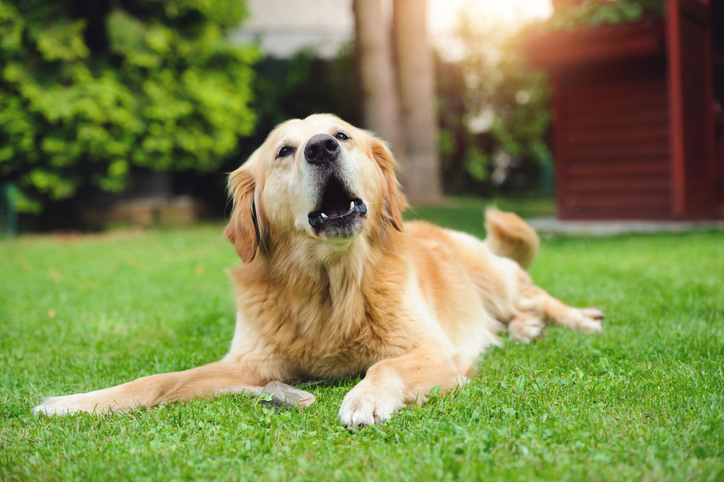What Do Different Types of Dog Sounds Mean
Dogs like to talk. Of course, they don’t use words, but they get their point across by using different sounds. Different dog sounds to communicate different things. Your dog knows which sound they need to make to get you to feed, pet, or play with them. As a dog parent, you learn your dog’s language. So, if you’re figuring out your dog’s communication, here are different types of dog sounds and what they mean.
Barking
Of all the dogs’ vocalizations, barking is the sound everyone attaches to a dog. When you ask a little child what a dog says, they say, “Woof.” Studies found that barks are a means of communication in dogs. Barks can be explosive, repetitive, or short clips. Different breeds and even individual dogs use barking for different reasons. Barking can be a group activity where one dog barks, setting off other dogs to bark. It’s thought that dogs can distinguish different acoustical sounds in another dog’s bark, which makes them react. If they don’t know a dog’s bark, they may bark in response out of fear rather than familiarity. Dogs often bark when they’re lonely or bored.
Little dogs have a higher-pitched bark because of their size. Big dogs have a greater lung capacity, so their bark is deeper and louder. Of all dog breeds, Golden Retrievers are considered to have the loudest bark.

Whining
Whining is attention-getting. Puppies often whine as their first communication. Their whining gets results, especially if you’re potty training! Older dogs whine if they’re scared, stressed, or in pain. Sometimes dogs whine to say they’re sorry after you scold them for chewing your sofa. Dogs also whine for food or to get something like a treat or a toy you have in your hand. Separation anxiety may cause a dog to whine. If your dog is whining as well as
- Panting
- Looks uncomfortable
- Loss of appetite
It might be worth taking them to the vet to be sure they’re not in pain from some ailment.
Whimpering
Whimpering is different from whining. A whimper means your dog is in distress. It’s often a yelping sound. Whining could mean your dog’s having pain because another dog bit them or someone stepped on their paw, and they let out a loud yelp. Some dogs whimper when they’re excited, for instance, when you come home after work. Dog whimpering isn’t as intense as whining, and it’s softer. Whimpering will stop when you find the cause. If your dog is whimpering, check them to look for physical problems that could put them in distress. Below are some reasons your dog may whimper:
- Scared
- Cognitive decline
- Illness
- Pain
- Fear
- Anxiety
- Grunting
Dogs also grunt. It’s a guttural sound that your dog makes when he lands on your bed or settles in his favorite blanket. Puppies sometimes grunt when they eat or while napping. Some dogs grunt when they’re upset. Your dog might make an irritated grunt when you don’t do what they want, such as taking them for a walk or playing ball with them. Every dog parent learns their dog’s communication sounds. Some dogs are noisier than other dogs.
Growling
A growling dog may seem aggressive but growling isn’t always an aggressive sound. Sometimes dogs growl due to fear, like when you’re going to cut their nails, or they are afraid of something outside, like a motorcycle going by. If someone knocks loudly at your door, your dog may growl to communicate they want to protect their territory. Dogs also growl to protect their toys, food, or when they’re in pain.
Of course, when a dog growls, it’s good to respect it. Sometimes dogs growl to show their dislike of another dog or person. They may be picking up on something you can’t know or see, so it bears paying attention when your dog growls.
Howling
Howling is a distinct dog sound. It’s often associated with certain hounds or hunting breeds, such as:
- Beagles,
- Bloodhounds
- Basset hounds
- Dachshunds
- Huskies
- Alaskan malamutes
- Alaskan Eskimo dogs
- Coonhounds
- Foxhounds
- Spitz
- Elkhounds
- Springer spaniels
Some howling almost sounds like singing. It has a musical sound, which is a throwback to a dog’s wild wolf ancestors who howled while in their packs to communicate.

Sighing
When your dog sighs, it sounds just like a human sigh. Dogs often sigh with contentment when they lie down in bed. But it can also indicate your dog is irritated with you for not taking him on a walk. They wanted attention and didn’t get it, so they’re “disappointed” with you. It feels very personal when your dog acts this way, so you get up and take him for a walk. No one wants to disappoint their dog!
Snorting
Does your dog snort? Certain breeds have a brachycephalic syndrome, a condition that flat-faced breeds of dogs have that makes breathing hard. They sound like they’re snorting. The flat-faced dog breeds that are more prone to this sound, includes
- Pugs
- Terriers
- Boxers
- Bulldogs
Although it’s common to these breeds, if your dog continues to snort for long stretches or seems uncomfortable when they snort, it’s best to see your vet to rule out infection or other breathing issues.
Sneezing
It’s easy to assume your dog is catching a cold when he sneezes. While that could be true, some dogs sneeze when they’re excited or to get your attention. A dog may sneeze every time you take them on a walk, not because they have allergies, but because they’re excited to be outside with you. If your dog sneezes and has a thick white, green, or yellow discharge from his nose, it could mean they are sick or have allergies. Talk with your vet to determine if it’s behavioral or an illness.
Your dog is communicating with you. They let you know when they’re hungry, need to do their business, or want you to play with them. Learning your dog’s different sounds and what they mean will help you give your pup the care they need.
Call our hospital at (603) 431-8785 or make an appointment if you have any questions at all related to your dog’s health and wellbeing.
Recent Posts
About Us
We're proud to have many long-time staff members at our hospital who get along like family and treat their patients and clients the same. The compassion and commitment of our veterinarians and staff make our team a reliable, trusted partner for you and your pet.

